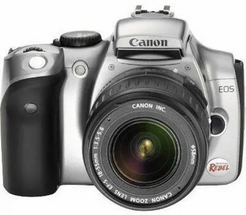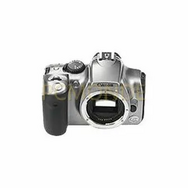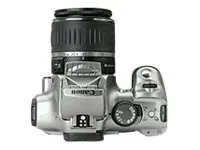
Canon Digital Rebel
| Brand | Canon 2003 |
| Model | 300D |
| Released Year | 2003 |
| Type | DSLR Cameras |
| Series | EOS |
| Status | Discontinued |
Overview
The Canon EOS 300D, also known as Digital Rebel, was launched in 2003 as one of the first affordable consumer digital SLR cameras. It features a 6.3-megapixel APS-C CMOS sensor delivering sharp and detailed images. The camera provides interchangeable EF and EF-S lens compatibility, enabling versatile shooting options. It uses DIGIC image processor technology for efficient image handling and improved color accuracy. The EOS 300D supports various shooting modes and has a built-in autofocus system with 7 points for precise focusing. Its interface includes a 1.8-inch LCD screen for playback and menu navigation.
Specifications
| MPN |
|
| EAN |
|
| Model | 300D / Digital Rebel |
| Battery Type | Lithium-Ion |
| Connectivity | USB |
| Colour | Black |
| Series | Canon EOS |
| Type | Digital SLR |
| Depth | 7.24cm |
| Height | 9.9cm |
| Width | 14.2cm |
| Item Weight | 560GR |
| Light Sensitivity |
|
| Display Type | LCD |
| Sensor Type | Cmos |
| Sensor Resolution | 6.3MP |
| Display Size | 1.8in |
| Features |
|
| Screen Size | 1.8in |
| Camera Type | Digital SLR |
| Maximum Resolution | 6.3MP |
| Lens for Sd |
|
| Supported Flash Memory | Compactflash I, Compactflash Ii |
| Optical Viewfinder Type | Eye-Level Mirror Pentaprism |
| Red Eye Reduction | Yes |
| Focal Length Range | 18mm-55mm |
| Lens Type | Zoom Lens |
| Flash Type | Pop-Up Flash |
| Sensor Size | 15.1x22.7mm |
| Still Image Format | Raw, Jpeg |
| Display Rotation | Built-In |
| Shooting Programs | Portrait Mode, Landscape, Stitch Assist, Sports Mode, Macro, Night Portrait, Close-Up |
| Light Sensitivity Max | 1600 |
| Viewfinder Type | Optical |
| Lens Aperture | F/3.5-5.6 |
Images
Key Advantages
The Canon EOS 300D Digital Rebel stood out with its affordability, democratizing DSLR photography. Its compact and lightweight body made it highly portable for consumers. The APS-C sensor offered excellent image quality for its class, with good low-light performance. Compatibility with Canon EF and EF-S lenses provided extensive creative control. The camera featured advanced autofocus for accurate subject tracking. Users benefited from user-friendly menus making it ideal for beginners transitioning from compact cameras.
Limitations
Despite its advantages, the EOS 300D was limited by its 6.3-megapixel resolution, which is low compared to later models. Its ISO range topped at 1600, limiting performance in very dim conditions. The LCD screen was smaller and less sharp than modern displays, restricting detailed image review. Continuous shooting speed was modest at around 2.5 frames per second. Video recording was not supported, as typical for DSLRs of that era. Battery life was average, requiring spare batteries for extended use.
FAQ
When was the Canon EOS 300D released?
The Canon EOS 300D was released in 2003.
What sensor does the Canon EOS 300D use?
It uses a 6.3-megapixel APS-C CMOS sensor.
Is the Canon EOS 300D still in production?
No, the Canon EOS 300D has been discontinued.
What type of lenses are compatible with the Canon EOS 300D?
The camera supports Canon EF and EF-S lenses.
Does the Canon EOS 300D support video recording?
No, the Canon EOS 300D does not support video recording.
What is the maximum ISO sensitivity of the Canon EOS 300D?
The maximum ISO sensitivity is 1600.
What is the continuous shooting speed of the Canon EOS 300D?
It can shoot continuously at approximately 2.5 frames per second.
Disclaimer
The content on is provided for general informational purposes only. We do not guarantee the accuracy, completeness, or reliability of any information, specifications, or visuals presented on the site.
is not responsible for any content, images, or data uploaded or shared by users. Users are solely responsible for the content they submit.
We may include links to third-party websites for convenience. We do not endorse or take responsibility for the content or policies of any external sites.
Use of the site is at your own risk. Always verify critical information independently before making decisions based on content from this website.


